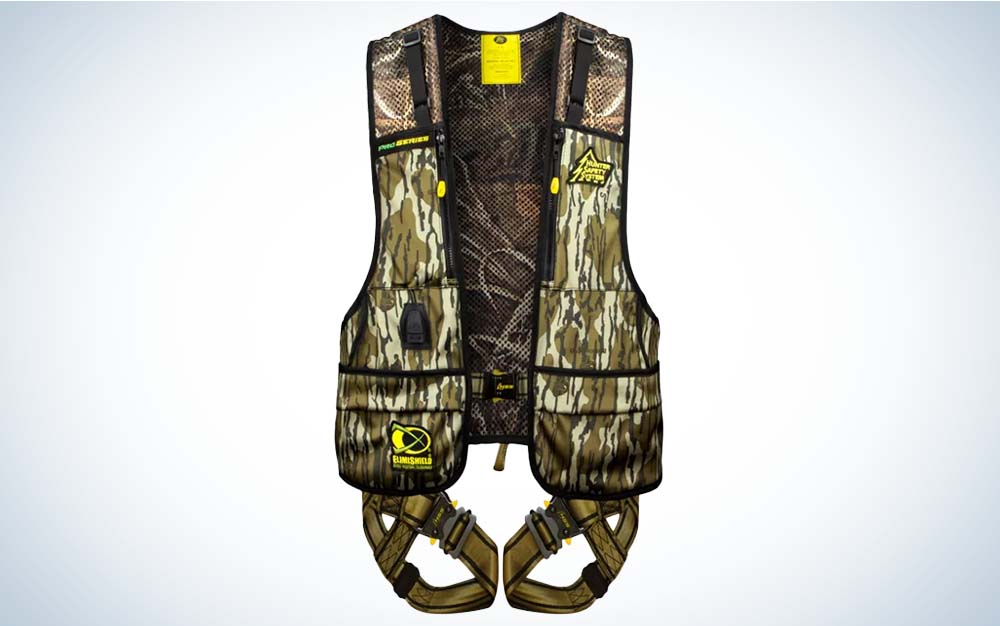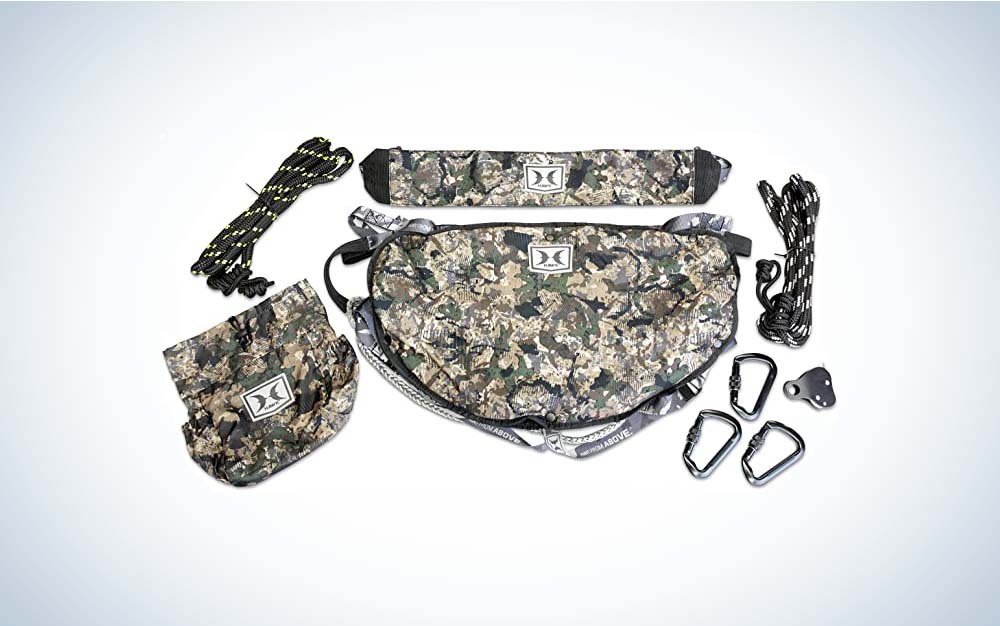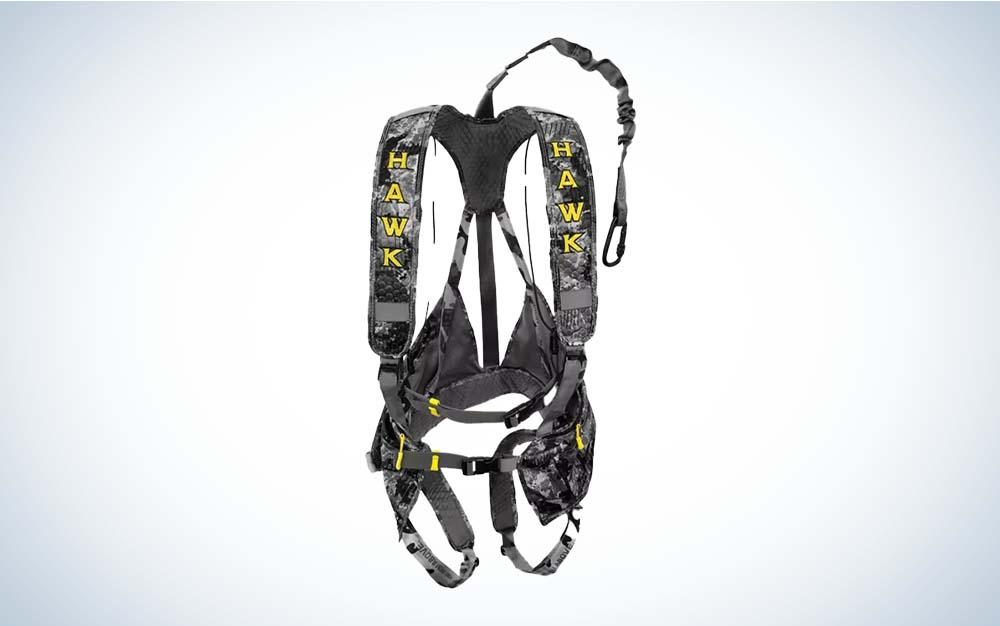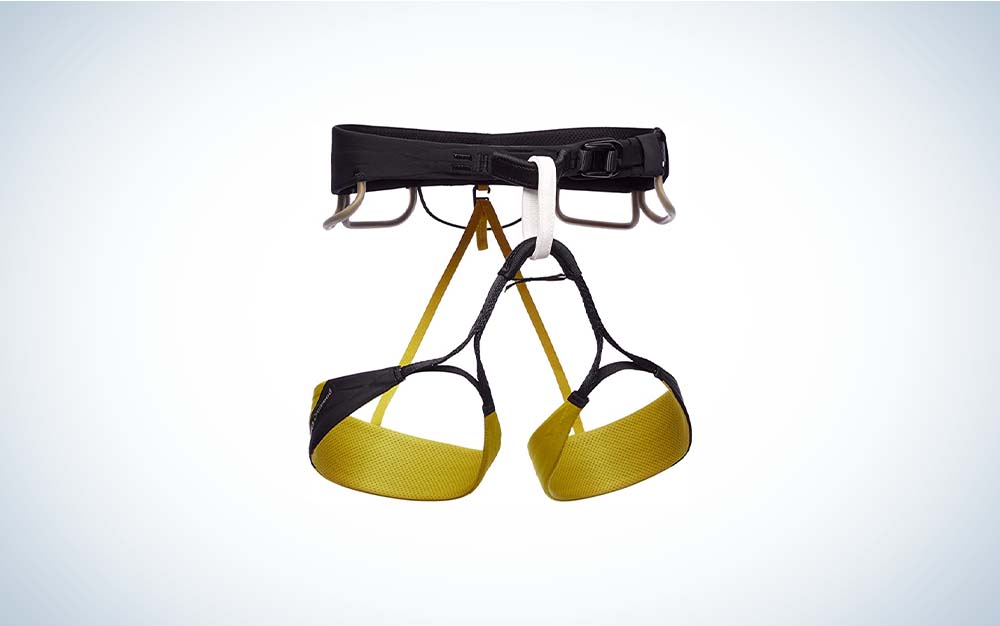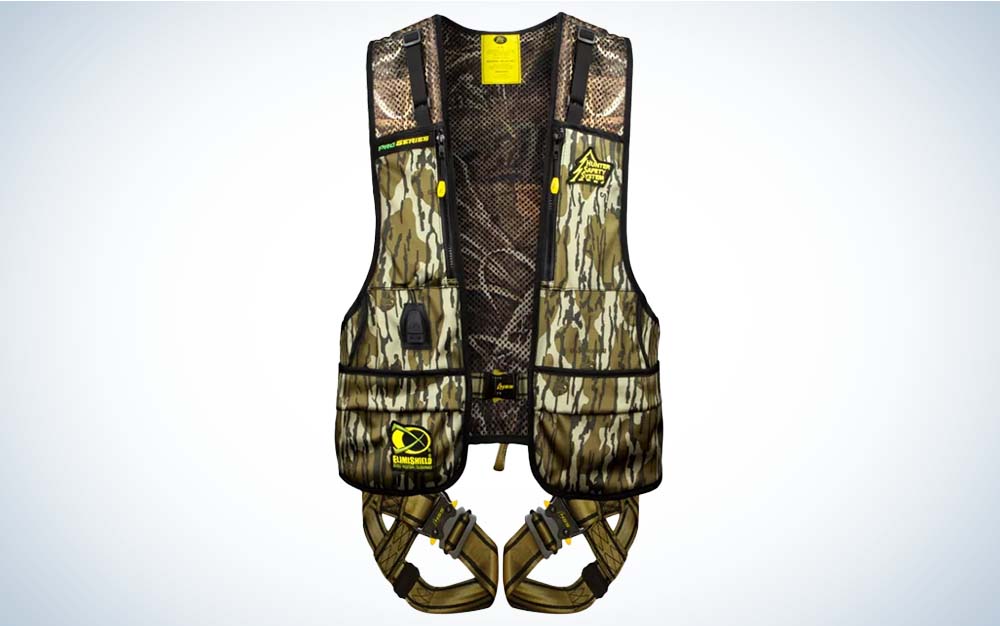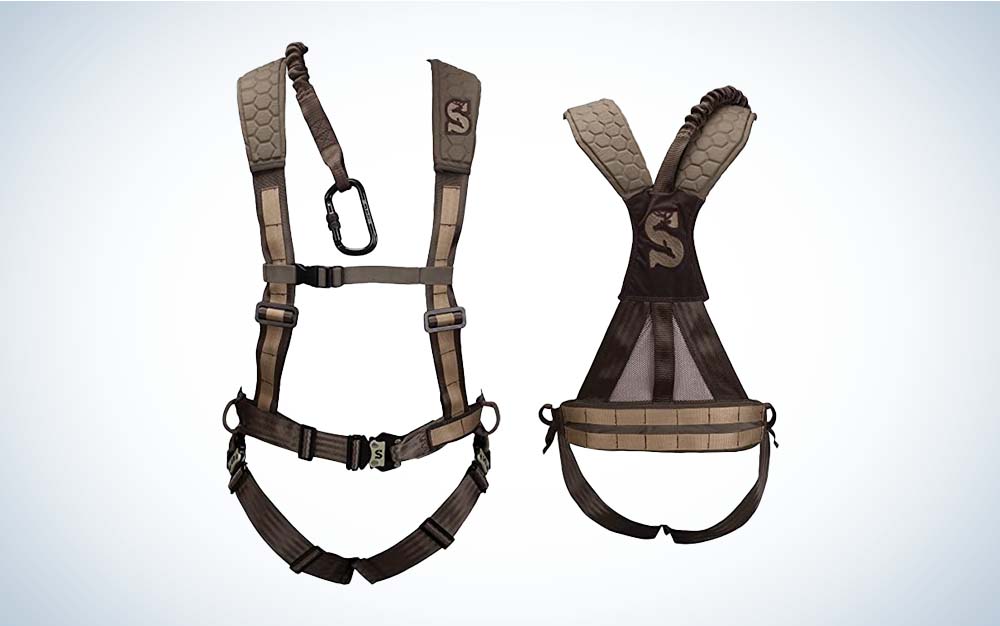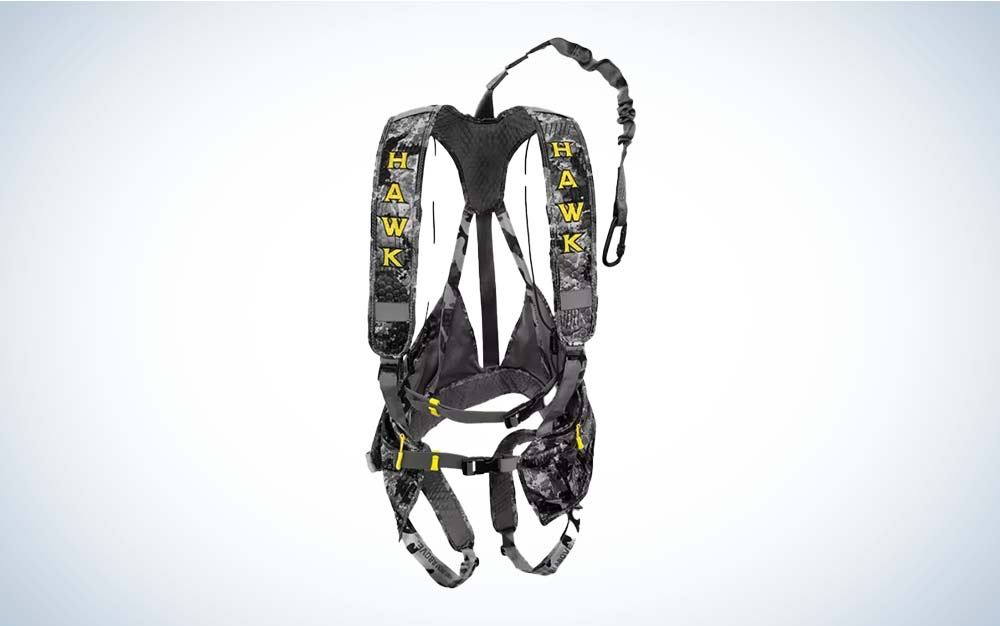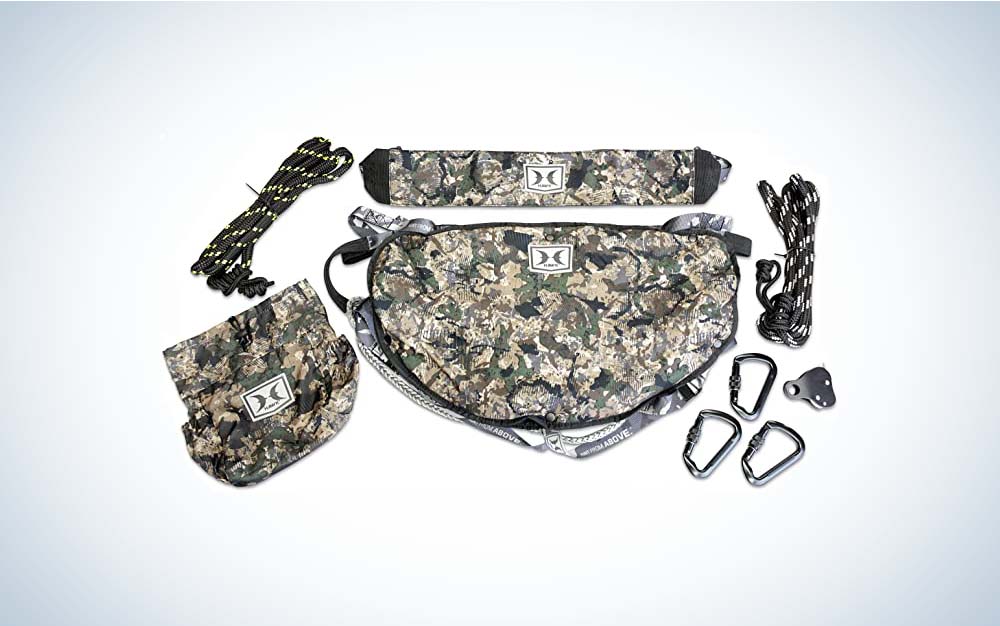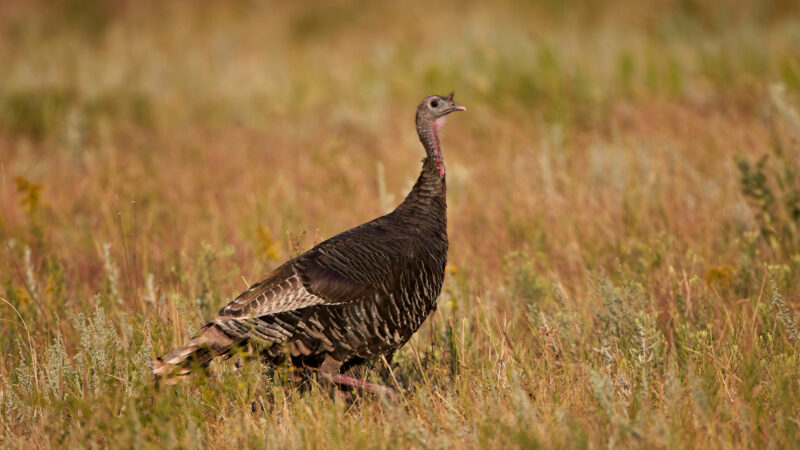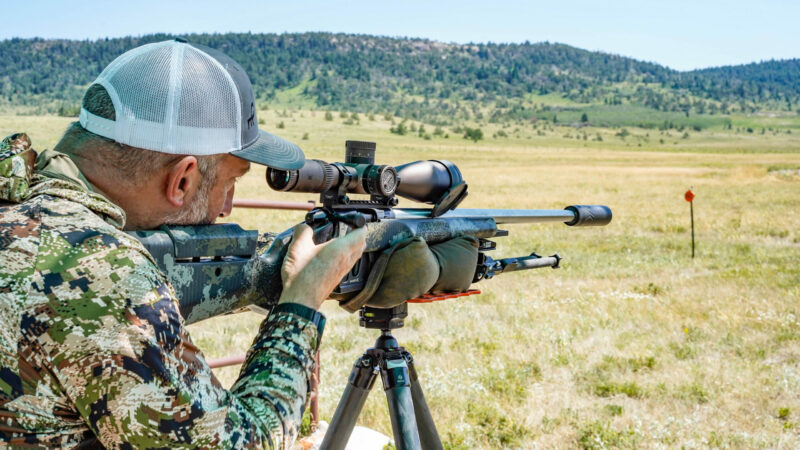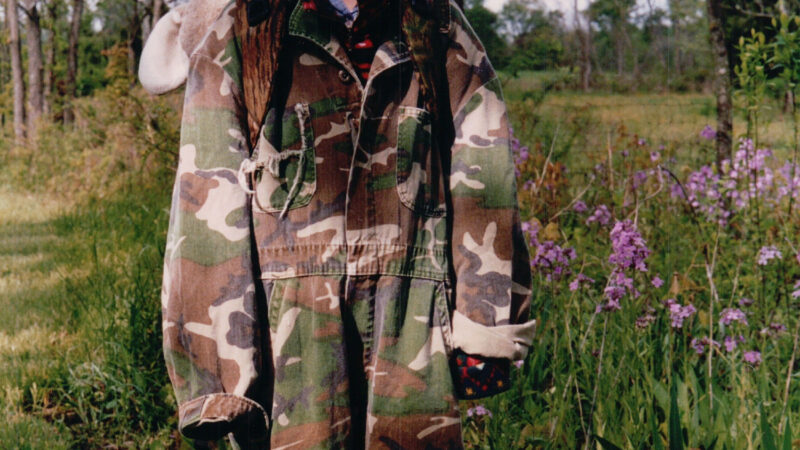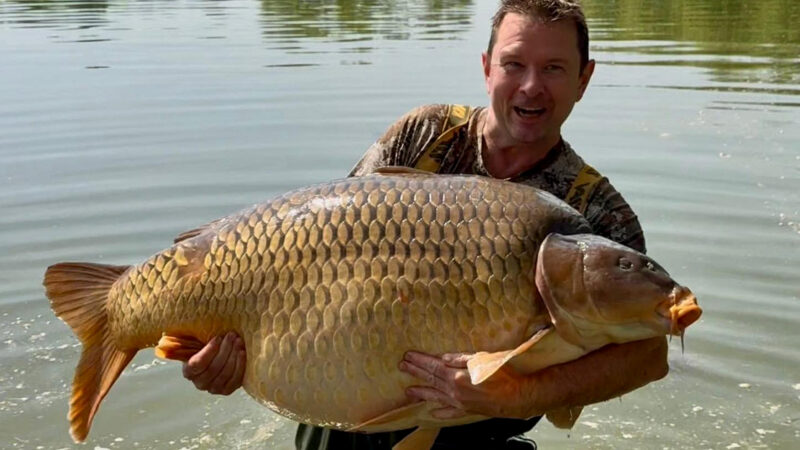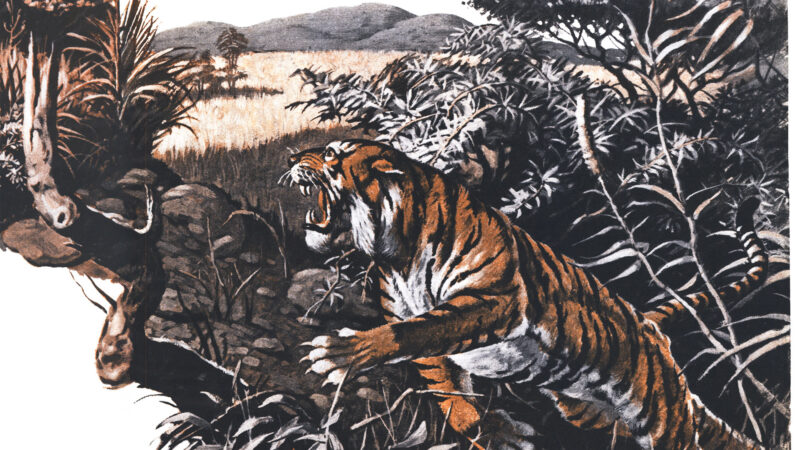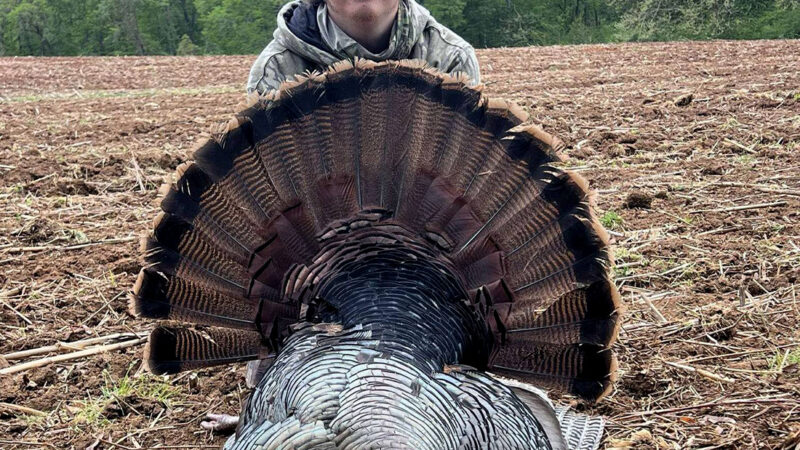Best Tree Stand Harnesses of 2023
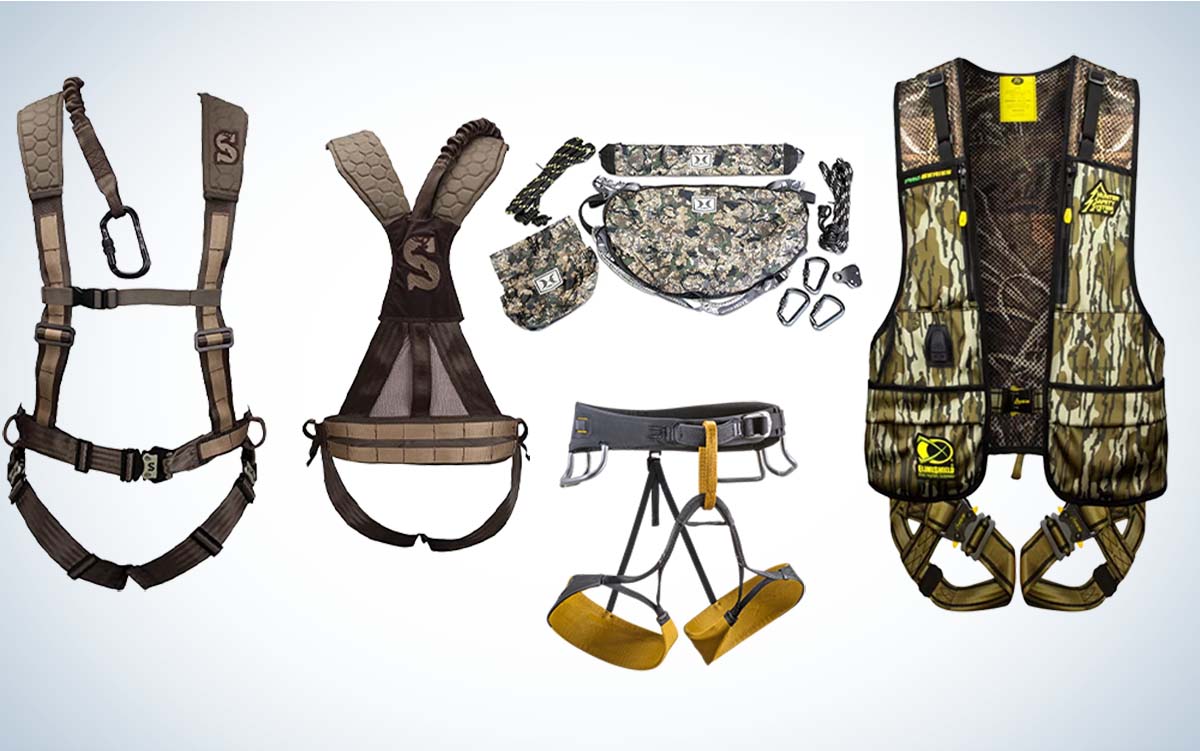
We may earn revenue from the products available on this page and participate in affiliate programs. Learn More ›
With over 50 years of hunting from tree stands and wearing tree stand harnesses and several decades studying tree stand safety for a living, I’ve been around long enough to recall when hunter safety classes chiefly focused on firearm safety rather than tree stand safety. I’ve also seen the old one-piece climbers evolve with better designs and better materials into some excellent portables today. Likewise I experienced the best tree stand safety harnesses evolve from belts to chest-harnesses to full-body harnesses.
- Best Harness Not Designed for Hunting: Black Diamond Zone Rock Climbing Harness
- Best Full Body: Hunter’s Safety System Pro
- Most Comfortable: Summit Pro Tree Stand Harness
- Best Features: Hawk Elevate Pro
- Best Saddle: Hawk Helium Saddle
How I Tested the Best Tree Stand Harnesses
In testing these harnesses, I used new samples straight out of the package and followed the manufacturers’ instructions. I weighed each complete unit using the same scale (AWS brand) so any error should be similar among them. For each harness type, I attached both the harness tree tether and lineman’s belt to the tree at the ground and climbed a few feet up using tree steps. I sat briefly with the tree tether properly positioned, and then simulated an arrested fall into the harness. Before and after use I inspected each harness to see if any damages occurred after the climbing and arrested fall simulations.
Best Tree Stand Harnesses: Reviews and Recommendations
Best Harness Not Designed for Hunting: Black Diamond Zone Rock Climbing Harness
Black Diamond
Key Features
- Weight: 0.9 lbs
- Sizes: XS to XL
- Recommended Lifespan: 10 years
- Weight Limit: None specified
Pros
- Simple to use
- Lightweight
- Easily remove/add layers
- Self-rescue is easier in this harness than the four-point harness
Cons
- Front tether attachment gets in the way
This is an extremely easy to use rock climbing harness that easily carries and supports hunters in a seated position after an arrested fall. The Black Diamond Zone is designed with the idea that users (climbers) are expected to fall in this harness. It is also designed for self-rescue, since rock climbers are often not easily accessible to rescuers. One of the reasons that full-body safety harnesses are recommended often for hunters is that it would be impossible for a hunter to fall out of a full-body harness if all the straps are fastened properly. Properly worn, the rock climbing harness provides almost as much security. Remember that rock climbers, unlike deer hunters, plan to fall and may be in unusual postures when they do so and count on these harnesses for survival.
Although the front attachment of the tether for rock harnesses could get in the way, the big advantage of this attachment point is that self-rescue becomes far easier after an arrested fall. Since this is a “sit” harness, hanging in these harnesses is much more comfortable than the full-body harness. Because you sit in this harness while suspended, unlike hanging in a full-body harness, the risk of suspension trauma is low.
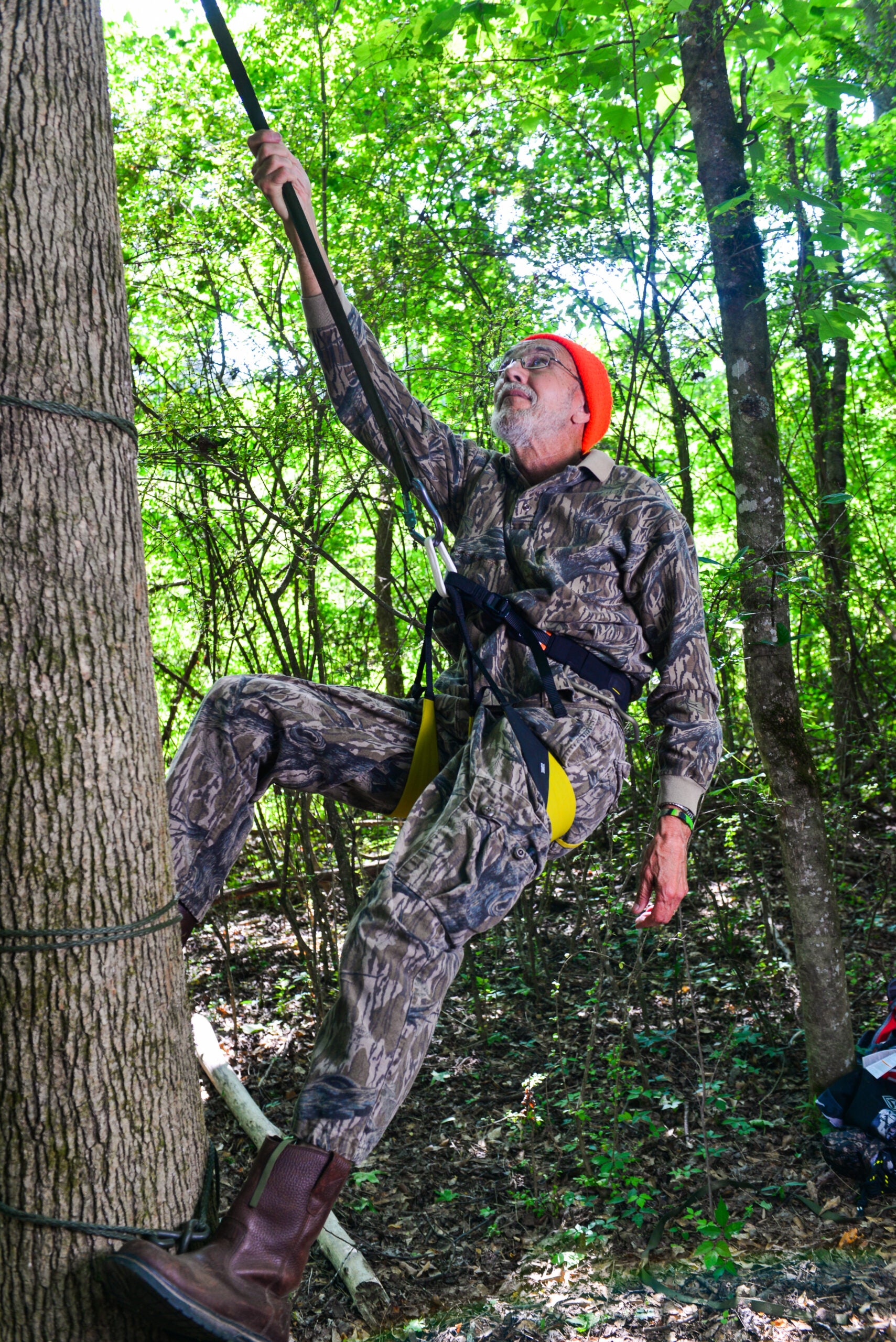
Because rock they’re usually tied-in to long climbing ropes, these harnesses do not include climbing loops, a tree belt or tether, so the hunter must fabricate these from climbing-grade rope or climbing-grade webbing (flat nylon tubular webbing used in climbing). A locking carabiner is also needed. If you are not confident in fabricating these, seek expert help from skilled hunters or rock climbers.
The second downside for hunters is that the tie-off point of the harness is located at the front waist. It is possible for the tree tether to be in the way of your bow or gun, but a little care will minimize this issue. When you use your harness to ascend a tree there is no “lineman’s” style belt, rather the harness is attached to a tree tether which must be moved up the tree. With a bit of practice this becomes easier. You’ll also want to add a small gear bag (not included) to store your tree tethers plus your up-haul rope.
This harness is great for hunters wanting a simple, lightweight safety harness that helps facilitate self-rescue. It is comfortable enough to wear on the walk to the stand and small enough to easily fit in a bowhunting backpack. You will need to fabricate or buy your own means of attachment to the tree for climbing and sitting, but this does permit some customization.
Best Full Body: Hunter’s Safety System Pro Series
Hunter’s Safety Systems
Key Features
- Eight Pockets including two zippered chest pockets
- Weight: Just under 4 pounds
- Includes two sets of instructions and instructional DVD
- Recommended Lifespan: Five years
- Weight Limit: 300 pounds
Pros
- Eight pockets are extremely handy
- Putting on/taking off the vest is easy
Cons
- Complex lineman’s belt procedure
- Self-rescue might be more challenging than other options on this list
This vest, like others of its type, has a harness tether attached to the middle of the back at the collar area. The tether with sewn-in shock absorption stays out of your way while hunting but can result in suspension facing away from the tree after an arrested fall. This orientation plus the length of the harness tether, especially if the shock absorbing stitching deploys, plus the major upward shift of everything in suspension, means you’ll be hanging far below your anchor point on the tree.
The lineman’s climbing belt seems very secure and is the only one I have seen that encircles the hunter’s entire body. However, the instructions for the lineman’s belt took me a while to interpret. But you’ll want to attach the tree tether whenever using the lineman’s belt to be doubly connected. This double-connection to the tree is vital for all harnesses if climbing past a limb or tree stand.
Hanging in this harness was uncomfortable, chiefly around the legs and crotch. And you’ll definitely want to wear this harness to the stand, as it doesn’t come with a carry pouch, and it would be a bit bulky to stuff in a pack. The long harness tether is a snag hazard and should be tucked inside the vest during travel—especially on an atv. But for tree stand hunters that want a full body harness with a snug fit and plenty of storage for your gear, the Hunter’s Safety System Pro Series is a great option.
Most Comfortable: Summit Pro Safety Harness
Summit
Key Features
- Weight: 4.5 pounds with just one tree strap
- Weight Limit: 300 pounds
- Recommended Lifespan: Five years (three years for the safety/lineman’s rope)
- Size: 28-35-inch waist (men’s)
Pros
- Simple, easy to use
- Small footprint
- Includes lineman’s belt
Cons
- The suspension-relief strap is difficult to return to its pouch
- For climbing into fixed stands, you’ll need a second rope to be tied in at all times
The Pro Summit Safety Harness is comfortable enough to wear on your hike to the stand, and the tied loop on the safety/lineman’s rope is large enough to pass the carabiner and prussic through without detaching it. This extremely adjustable harness includes a stretchy chest strap that reduces the chances of strangulation if you sink too low in the harness while suspended. Because it’s so adjustable, this harness is plenty comfortable to wear on your trek to the stand and for those all-day sits. There are no pouches included, so the tree tether/lineman’s climbing strap must be carried separately.
The tree tether has an energy-absorbing section as well as sewn-in tear-outs. But the design of the harness made it hard for me to reach the vest tree tether without removing the shoulder straps. It does include a suspension-relief strap in a handy storage pouch that’s connected to the harness, which is fastened at one end and then deployed and attached to the lineman’s belt loop.
When you tie-off the strap, try a slip knot, as I needed two tries to get the loop length correct. It took some wiggling to stand up in the suspension-relief strap, so practice several times near the ground before hunting with it. Still, the Summit Pro is one of the more comfortable harnesses from my test, and is a great option if you’ve got a long walk and an all day sit planned for your next hunt.
Best Features: Hawk Elevate Pro Harness
Hawk Hunting
Key Features
- Weight: 3.7 pounds with tree and climbing belt
- Recommended Lifespan: Five years
- Weight Limit: 300 pounds
- Quick-release leg buckles
Pros
- Super easy to put on/take off
- Padded leg straps are an excellent touch
- Convenient pockets
Cons
- Might not fit smaller hunters super well
The Hawk Elevate Pro Harness has so many thoughtful features that make it extremely comfortable and convenient to use when you’re in the stand. This “one-size-fits-most” harness was a little too big on me at 5-foot 8-inches and 140 pounds. So a smaller size would benefit smaller stature hunters. While it doesn’t seem like a big deal, the size issue becomes more important during an arrested fall. The leg strap pads were a bit too far back, though still somewhat effective. Likewise the size of the harness resulted in some of my weight being suspended at my armpits rather than evenly distributed. You can mitigate the size problem with more clothes, but there are plenty of single layer hunting days during the early season and deep South.
The tree tether has a shock-absorbing section as well as tear-out pleats. I was able to reach the tether while wearing the vest, and the harness comes with both a tree belt and a climbing rope with a prusik knot. The looped end of the climbing rope was big enough to slide the prusik and carabiner through. In general this harness was impressive in the consideration of practical aspects of use. For example the tree belt has a sewn-in attachment loop for connecting the carabiner. Like the Summit, the suspension-relief strap is included and can be conveniently placed back in its storage pouch.
When you tie it off, use a slip knot to aid in getting the loop length correct. The shorter climbing rope means it is easier to handle with less excess flopping around. However, it would not be long enough for large-diameter trees. The harness adjustment belts have clips built in for housing the tag ends so that they don’t flop about. Even the loops for attaching the climbing belt have elastic holders to keep the loops out of the way when not in use. And the suspension strap has two velcro tabs for refolding when you store it. There are so many subtle but thoughtful details in the Hawk Elevate Pro that make it one of the best tree stand harnesses not just to wear, but to make your time in the stand that much more efficient.
Best Saddle: Hawk Helium Hammock Saddle
Hawk Hunting
Key Features
- Weight: 4.3 pounds
- Weight Limit: 300 pounds
- Sizes: 28-40-inch waist
Pros
- With additional equipment, saddle doubles as your stand
- Super comfortable after an arrested fall
- Self-rescue is easier than conventional tree stand harnesses
Cons
- Takes some getting used to
- A bit bulky
The Hawk Helium Hammock Saddle combines your stand and tree stand harness in one convenient, lightweight package. If you’re a minimalist hunter, and you haven’t already bought into the tree saddle hype yet, the Hawk Helium Hammock Saddle should catch your eye. This safety tree harness/stand combines the best of both worlds in a lightweight, packable option. Like the Black Diamond, this isn’t a traditional tree stand harness, though it certainly functions as one. Whether you wear it to your stand or pack it in, this saddle eliminates a lot of unwanted weight, especially if you have a long hike to the stand.
Compared to vest-type hunting harnesses and rock climbing harnesses, the Hawk Helium Saddle does have more dangling parts. I would definitely advise plenty of trial runs with it at ground level to familiarize yourself with specific adjustments and how to put it on. As a harness, this is one of the heavier ones I tested at 4.3 pounds. As a stand, though, it’s much lighter than most portables out there and will cut down on your overall weight.
The tree tether spliced loop is a bit small for the prusik knot or for the mechanical ascender. This means the prusik or the ascender must be removed to attach the tree tether to the tree. If you drop one, you better have a spare in your pouch.
There were no instructions for attaching the carrying pouch to the saddle, which is vital to carry the ascender and the prusik. Fitting the Saddle into the carrying pouch takes some effort and practice. But once you get the hang of it, the Hawk Helium Hammock can make your tree stand hunts much more efficient.
Things to Consider Before Buying a Tree Stand Harness
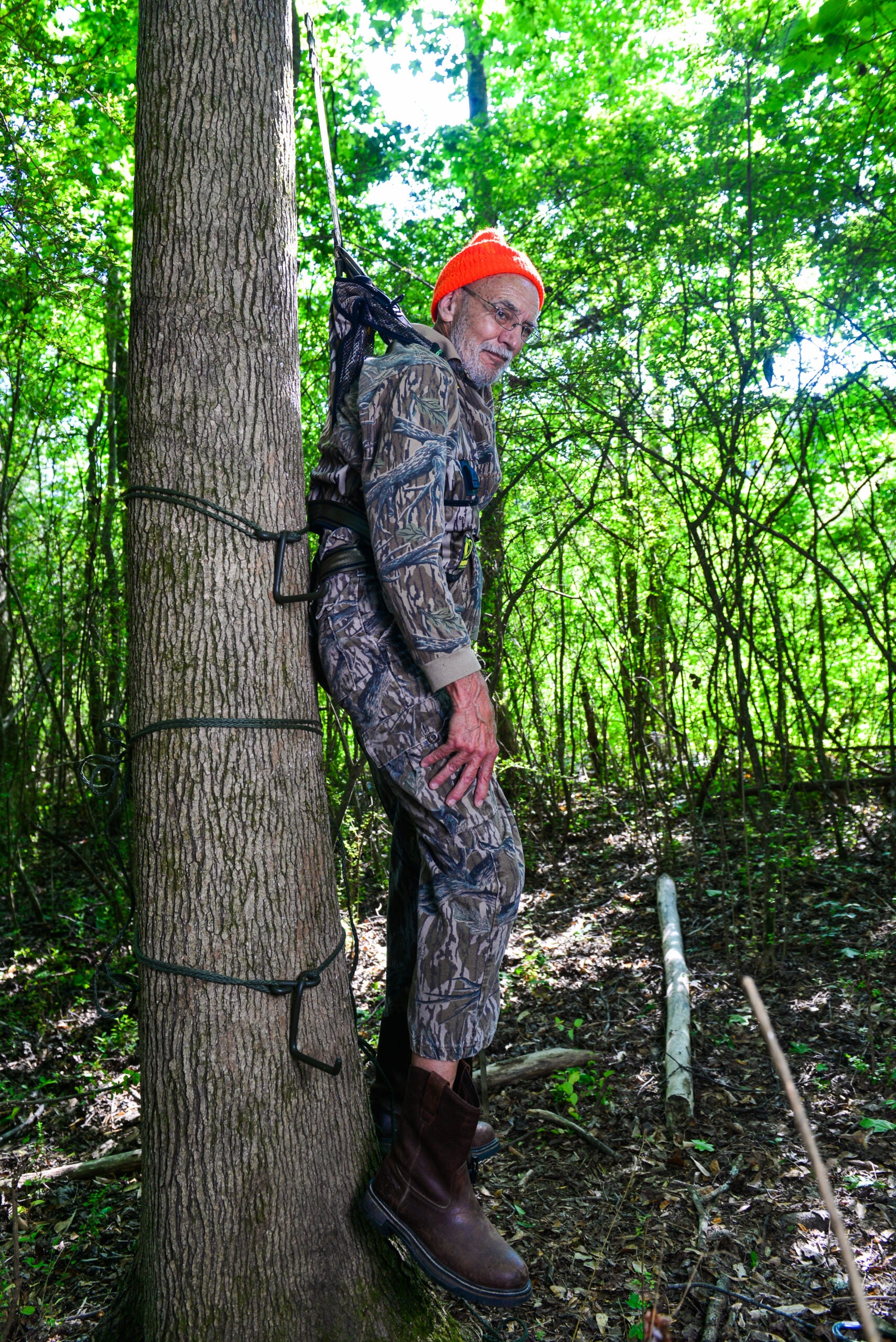
As a retired professor of exercise physiology, I’ve spent years researching and studying tree stand accidents and safety. This is one reason I wear a harness every hunt, from the ground up to hunting height and back to the ground again. And I strongly recommend you do the same. I am a small guy who, probably like you, hauls my bow or rifle, my range finder, binoculars for hunting, extra gear and clothing, on my back considerable distances to and from my stand. And while a tree stand harness might seem like an afterthought compared to your other gear, it shouldn’t. Whether you’re hauling a ton of gear into a deep piece of public or doing a quick hunt behind the house after work, you should treat your tree stand harness just as vital as the weapon you’re hunting with.
There are three basic types of safety harnesses. The most popular harnesses currently are full-body harnesses and vests made specifically for tree stand hunting. This contractor style full-body harness is the only type currently approved by the Tree stand Manufacturer’s Association. The second type of harness, which has become increasingly popular in the last few years is the tree saddle.
Essentially, these are fabric seats with leg straps and a bridge which can be attached to a tree tether and allow you to hang in a tree and rest with your feet to an attached footrest or stand. These allow you to move around the tree to shoot in any direction. The final type of harness I tested—which isn’t your typical tree stand harness—is a rock climbing harness. These harnesses are built for rock climber’s safety to prevent them from falling as they scale cliffs and other rock faces. Because they work brilliantly for ascending/descending, they also make great options for tree stand harnesses when worn properly.
You’ll want a harness that you feel comfortable using every time you head to the stand. Different hunters will have different ideas of which features are most important. Try out as many harnesses as you can and see which ones fit or accommodate your size and needs best. If you can, borrow one from your hunting buddy to see how it fits. If you have the opportunity to test the harness at ground level, do so.
Hang a tree stand near ground level for your self-rescue test and see if you can climb back to safety. What if your tree stand falls? Can you get to the ground? Does the harness feel restrictive in any way or cause discomfort? These are factors that you should consider when purchasing a tree stand harness. Stay close enough to the ground to put your feet down for a simulated self-rescue. Be sure to make sure the suspension-relief strap works, and do this with a strong adult present.
I have worn a lot of different types of hunting safety harnesses. All of them can help protect against tree stand falls, which is their key function, but some are a lot more practical than others. Here are three main factors you should consider when looking to purchase one.
Ease of Use
The most important feature of a harness, in my opinion, is ease-of-use. I say this because mine and my colleague’s scientific survey research shows that many hunters, even hunter safety instructors, fail to wear a harness simply because they are difficult to use. The harder it is to use, the less likely hunters are to wear it. While this isn’t a good reason not to wear a harness, unfortunately, it’s a reality for a lot of hunters. Ease of use includes overall weight, how easy it is to put on/take off, how it wears to/from the stand, and general convenience.
Recovery After a Fall
The second most important feature is how easy the recovery process is if a fall occurs. If a fall happens to occur and the harness does its job of keeping you from hitting the ground, it must either allow you to regain the stand or safely descend. Hanging in most harnesses quickly becomes painful, and in some cases can cause you to lose consciousness. In extreme cases it has resulted in death (due to suspension trauma), so an effective harness escape plan is vital. And, this is not always easy.
Comfort
Comfort is another key quality of tree stand harnesses. Like harnesses that are difficult to put on, an uncomfortable harness will either get left in the truck or detract from your hunt. As the air temperature of the hunt changes, a harness that allows you to put on or take off extra layers can make your hunt way more enjoyable and efficient.
FAQs
Q: Do I need a harness for hunting?
Absolutely. If you hunt from any elevated stand that isn’t fully enclosed, then you shouldn’t leave the ground without a tree stand harness anchored securely.
Q: What is the best treestand harness?
The best harness is the one you will use every time you leave the ground. For different hunters, that will vary. I love simplicity and a harness that I can don at the truck and wear to the stand. Personally, I prefer a harness that allows me to be rest in a sitting position if I fall into it—for comfort and safety from suspension trauma. But you might have different criteria, so list your needs and find a harness that you’ll like and use.
Q: What is the lightest safety harness?
The heaviest harness and the lightest harness I have weighed only differed by about 3.5 pounds. For most of us that is a negligible difference. If you are packing in a lot of gear a long distance, a rock climbing harness will likely be the lightest option. However, once you consider the weight of a portable stand plus your harness, a tree saddle will cut down on your total weight overall and likely be the lightest option.
Q: Should I wear a harness in a tree stand?
You should wear a harness and be connected to a safety line from the moment you leave the ground to the moment you return.
Why Trust Outdoor Life?
Since 1898, OL has been a leading authority in testing and reviewing hunting gear, fishing tackle, guns and shooting equipment, and much more. We have more than a century-long history of evaluating products, and we’re now bringing that expertise to online reviews. Our editors are experienced outdoorsmen and women, and most importantly, we’re trained journalists. We prioritize field testing and objective data when reviewing products. We conduct interviews with gear manufacturers and engineers as well as outdoor experts so that our readers have an understanding of how and why a product works—or doesn’t.
Advertising does not influence our gear reviews and it never will. While we always focus our coverage on standout products—because we want our readers to be aware of the latest and greatest gear—we also cover the flaws and quirks of any given product.
Final Thoughts on the Best Treestand Harnesses
The best tree stand harnesses could well save your life or prevent a hunting-ending injury. The key issue is to find a harness design that you will use properly every hunt. Wear it from the ground up and down again and always have it firmly anchored. Inspect your harness before each use and do not exceed the expiration date or weight limit for it. Follow manufacturers’ warnings, and don’t expose harnesses to the weather when not in use. Make sure you can self-rescue from suspension. And above all, be safe.
- Best Harness Not Designed for Hunting: Black Diamond Zone Rock Climbing Harness
- Best Full Body: Hunter’s Safety System Pro
- Most Comfortable: Summit Pro Tree Stand Harness
- Best Features: Hawk Elevate Pro
- Best Saddle: Hawk Helium Saddle
The post Best Tree Stand Harnesses of 2023 appeared first on Outdoor Life.
Articles may contain affiliate links which enable us to share in the revenue of any purchases made.
Source: https://www.outdoorlife.com/gear/best-tree-stand-harnesses/
